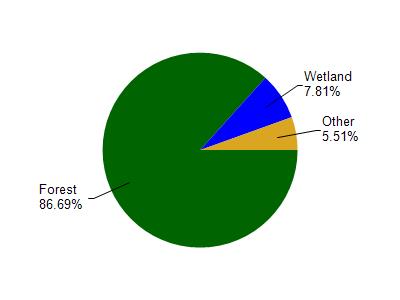Bayfield
Yes
Yes
No
Fish and Aquatic Life
Overview
The East Fork Cranberry River is the major tributary to the Cranberry River and accounts for the majority of the flow in the Cranberry River. This entire stream is considered Class I trout waters and supports migratory trout runs from Lake Superior. This stream drains relatively wild land and the stream bed is primarily sand and gravel and boulders.
During survey work conducted as part of the coastal wetlands evaluation, four rare species of macroinvertebrates were found and overall taxa richness was high (25 or more species) (Epstein 1997). The survey noted significant turbidity in the stream, with significant bank erosion present as well as impacts from impoundment. To a lesser extent, potential pollutant sources include livestock operations, barnyards, cropland and failing septic system. Present at survey sites were aquatic plants and filamentous algae.
Wisconsin Trout Streams incorrectly refers to a major tributary to the East Fork as T50N R7W S25. It actually enters the East Fork in Section 28. Because of this, the stream is also incorrectly identified in the NR102 list of outstanding and exceptional waters. This sand and gravel-bottomed tributary is popular with migratory trout for spawning. The majority of the streambank vegetation is tag alder. Abundant in-stream cover occurs in the form of rocks, logs, deep pools and undercut banks.
Date 1999
Author Aquatic Biologist
General Condition
The East Fork Cranberry River was assessed during the 2018 listing cycle; new biological (fish Index of Biotic Integrity (IBI) scores) sample data were clearly below the 2018 WisCALM listing thresholds for the Fish and Aquatic Life use. This water was meeting this designated use and was not considered impaired.
Date 2017
Author Ashley Beranek
Condition
Wisconsin has over 84,000 miles of streams, 15,000 lakes and milllions of acres of wetlands. Assessing the condition of this vast amount of water is challenging. The state's water monitoring program uses a media-based, cross-program approach to analyze water condition. An updated monitoring strategy (2015-2020) is now available. Compliance with Clean Water Act fishable, swimmable standards are located in the Executive Summary of Water Condition in 2018. See also the 'monitoring and projects' tab.
Reports
Management Goals
Wisconsin's Water Quality Standards provide qualitative and quantitative goals for waters that are protective of Fishable, Swimmable conditions [Learn more]. Waters that do not meet water quality standards are considered impaired and restoration actions are planned and carried out until the water is once again fishable and swimmable
Management goals can include creation or implementation of a Total Maximum Daily Load analysis, a Nine Key Element Plan, or other restoration work, education and outreach and more. If specific recommendations exist for this water, they will be displayed below online.
Monitoring
Monitoring the condition of a river, stream, or lake includes gathering physical, chemical, biological, and habitat data. Comprehensive studies often gather all these parameters in great detail, while lighter assessment events will involve sampling physical, chemical and biological data such as macroinvertebrates. Aquatic macroinvertebrates and fish communities integrate watershed or catchment condition, providing great insight into overall ecosystem health. Chemical and habitat parameters tell researchers more about human induced problems including contaminated runoff, point source dischargers, or habitat issues that foster or limit the potential of aquatic communities to thrive in a given area. Wisconsin's Water Monitoring Strategy was recenty updated.
Grants and Management Projects
| Project Name (Click for Details) | Year Started |
|---|
|
|
Monitoring Projects
| WBIC | Official Waterbody Name | Station ID | Station Name | Earliest Fieldwork Date | Latest Fieldwork Date | View Station | View Data |
|---|
| 2880000 | East Fork Cranberry River | 10031241 | East Cranberry Longterm Coho Index Station | 11/3/2009 | 1/1/2015 | Map | Data |
| 2880000 | East Fork Cranberry River | 10015371 | Lower East Fork Cranberry River | 9/30/2007 | 1/1/2015 | Map | Data |
| 2880000 | East Fork Cranberry River | 10015394 | East Fork Cranberry River- 50 M Upstream Lenawee Rd- Station #1 | 1/1/2015 | 11/22/2022 | Map | Data |
| 2880000 | East Fork Cranberry River | 10030490 | East Fork Cranberry River - Downstream of Touve Rd | 8/26/2009 | 1/1/2015 | Map | Data |
| 2880000 | East Fork Cranberry River | 10040128 | East Fork Cranberry River 150ft S of Cranberry River Rd | 9/16/2013 | 1/1/2015 | Map | Data |
| 2880000 | East Fork Cranberry River | 10038133 | Cranberry River 130' US of Touve Rd | 5/21/2012 | 1/1/2015 | Map | Data |
| 2880000 | East Fork Cranberry River | 10031240 | East Cranberry Upstream of Lenawee Creek | 1/1/2015 | 1/1/2015 | Map | Data |
| 2880000 | East Fork Cranberry River | 10015395 | East Fork Cranberry River- Upstream Confluence Of Lenawee Creek- Station #2 | | | Map | Data |
| 2880000 | East Fork Cranberry River | 10031239 | East Fork Cranberry Below Bratley Game Farm Fence | 1/1/2015 | 1/1/2015 | Map | Data |
|

Watershed Characteristics
East Fork Cranberry River is located in the Bayfield Peninsula Northwest watershed which is 236.05 mi². Land use in the watershed is primarily forest (86.60%), wetland (7.80%) and a mix of grassland (4.60%) and other uses (0.90%). This watershed has 473.06 stream miles, 43,216.55 lake acres and 6,677.27 wetland acres.
Nonpoint Source Characteristics
This watershed is ranked Not Ranked for runoff impacts on streams, Not Available for runoff impacts on lakes and Low for runoff impacts on groundwater and therefore has an overall rank of Low. This value can be used in ranking the watershed or individual waterbodies for grant funding under state and county programs.However, all waters are affected by diffuse pollutant sources regardless of initial water quality. Applications for specific runoff projects under state or county grant programs may be pursued. For more information, go to surface water program grants.